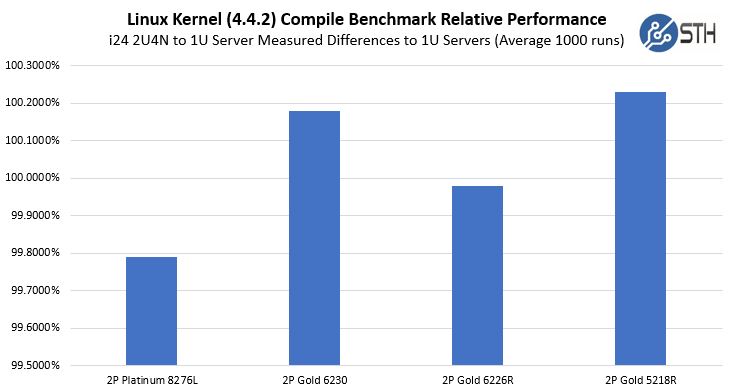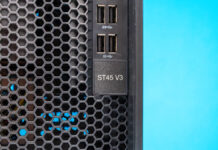Inspur i24 2U4N Test Configuration
For our testing we used the following configuration:
- System: Inspur i24 4-node configuration
- CPUs (in pairs): Intel Xeon Platinum 8276L, Intel Xeon Gold 6230, Xeon Gold 6226R, Intel Xeon Gold 5218R
- Memory: 384GB (12x 32GB) per node
- SSDs: 2x Samsung PM883 240GB SATA OS and 2x Intel DC S3710 400GB SSDs per node
- OCP LAN: Mellanox ConnectX-4 Lx 25GbE/ Intel X710 SFP+ 10GbE
This is a fairly lightweight configuration but these would be typical configurations for this server.
Next, we are going to look at the Inspur i24 performance before giving our final thoughts.
Compute Performance and Power Baselines
One of the biggest areas that manufacturers can differentiate their 2U4N offerings on is cooling capacity. As modern processors heat up, they lower clock speed thus decreasing performance. Fans spin faster to cool which increases power consumption and power supply efficiency.

STH goes through extraordinary lengths to test 2U4N servers in a real-world type scenario. You can see our methodology here: How We Test 2U 4-Node System Power Consumption.
Inside this configuration, what we are testing for is the ability for these dense 2U4N systems to keep processors cool compared to baseline 1U systems. In previous generations, one issue many systems had was that there would be wide performance deltas between 1U1N (1U 1-node) and 2U4N (2U 4-node) platforms because processors would throttle under load. An ideal result is that a 2U4N platform matches the performance of 1U1N performance since that would mean that cooling is sufficient to allow processors to run at their maximum turbo frequencies.
Inspur i24 Compute Performance to Baseline
We loaded the Inspur i24 with a few configurations to see the performance compared to our average 1U system performance. We then ran one of our favorite workloads on all four nodes simultaneously for 1400 runs. We threw out the first 100 runs worth of data and considered the 101st run to be sufficiently heat soaked after days of testing. The other runs are used to keep the machine warm until all systems have completed their runs. We also used the same CPUs in both sets of test systems to remove silicon differences from the comparison.
This is an extraordinarily labor-intensive process, but it is done to eliminate variables.


Here, please note this is not using a 0 Y-axis. The differences are sub 0.3% so they would all look as though they are exactly on the 100% marker. The key takeaway is that we are within test variances for different runs, even using a large number of runs. Especially with loading heavy AVX-512 usage, we would have seen a more significant delta if there was strong thermal throttling.
With these results, it seems as though the Inspur i24 is running CPUs at their full performance levels without throttling CPUs in the process.
Next, we will continue with our power consumption testing along with our STH Server Spider and final words.




The units should also support the new Series 200 Intel Optane DCPMMs, but only in AppDirect (not Memory) mode.
U.S. Forces Intel to Pause Shipments to Leading Server Maker.
Tomshardware
Intel Restarts Shipments to Chinese Server Vendor
Tomshardware
How do you get to CMC management’s?